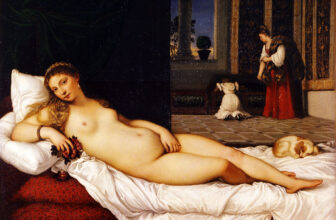Renaissance Paintings of Women
The Renaissance era was a time of great change and innovation in the arts, including painting. It was a time of exploration and discovery, where artists pushed the boundaries of what was possible and developed new techniques and styles that continue to inspire and captivate us to this day. One of the most fascinating aspects of Renaissance painting is the way that it depicted a woman, their bodies, their dress, and even their pets. In this article, we will explore the various themes and motifs that emerged in renaissance painting of woman, from the politics of the time to the seductive power of beauty.
1. Mona Lisa : Leonardo da Vinci
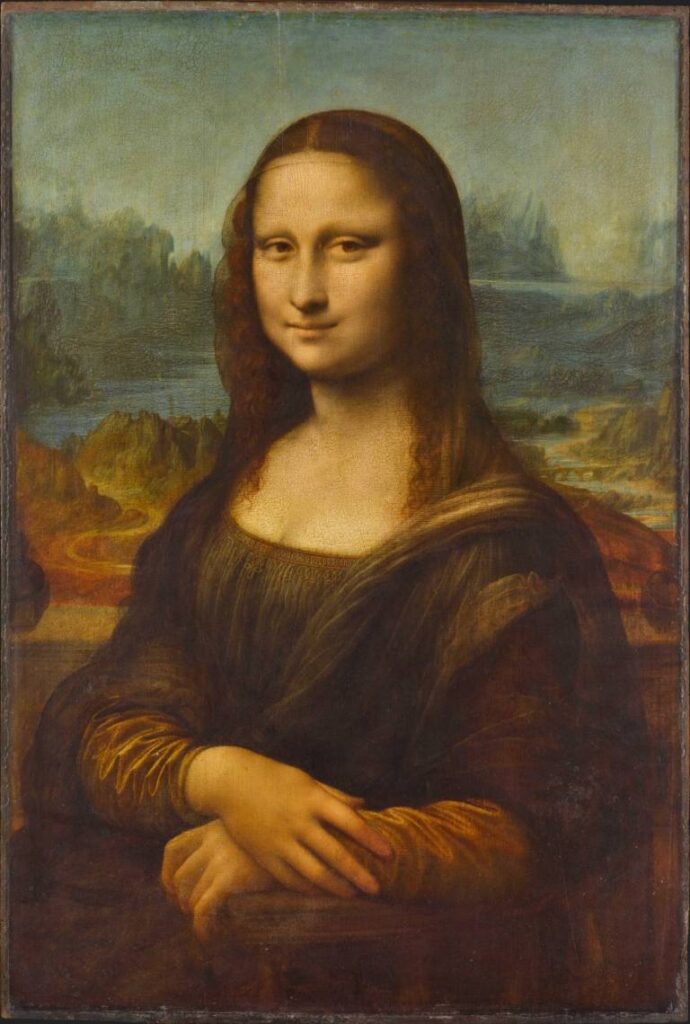 Mona Lisa Renaissance Painting of Woman |
The Mona Lisa, painted by Leonardo da Vinci in the early 16th century, is one of the most famous and celebrated artworks of the Renaissance. The subtle smile of the subject, Lisa Gherardini, adds to the intrigue, as viewers perceive different emotions depending on the angle and lighting. The Mona Lisa gained fame due to its theft in 1911, which sparked worldwide attention. Its presence in the Louvre, where millions visit it annually, solidifies its status as an artistic and cultural icon. Combined with Leonardo’s reputation as a genius of the Renaissance, the painting remains an enduring masterpiece that captivates audiences across centuries.
2. The Birth of Venus : Sandro Botticelli
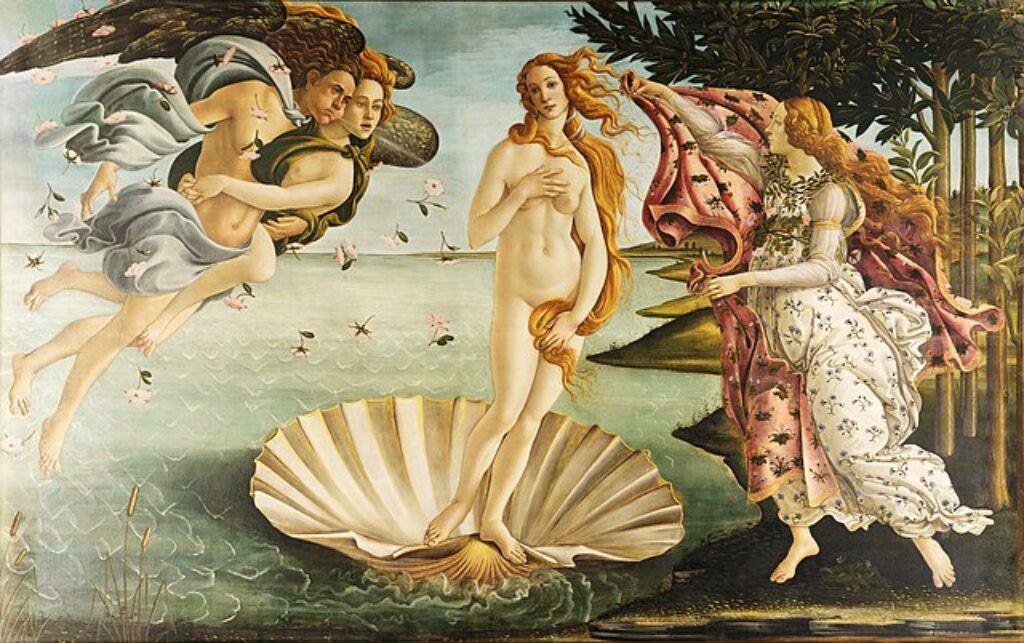 The Birth of Venus Renaissance Painting of Woman |
The Birth of Venus, painted by Sandro Botticelli in the 15th century, is one of the most famous masterpieces of the Italian Renaissance. It stands out for its ethereal beauty, graceful composition, and mythological theme, depicting the goddess Venus emerging from the sea on a shell. The painting is renowned for its delicate use of color, elegant figures, and flowing lines, which create a dreamlike quality. Unlike many Renaissance works that focus on religious subjects, The Birth of Venus celebrates classical mythology, reflecting the humanist ideals of the era. Botticelli’s innovative use of tempera on canvas instead of wood paneling was also groundbreaking. The painting’s enduring fame is due to its idealized representation of beauty, harmony, and love. Its influence can be seen in countless artworks and popular culture, making it an iconic symbol of the Renaissance’s artistic and intellectual achievements.
3. Lady with an Ermine : Leonardo da Vinci
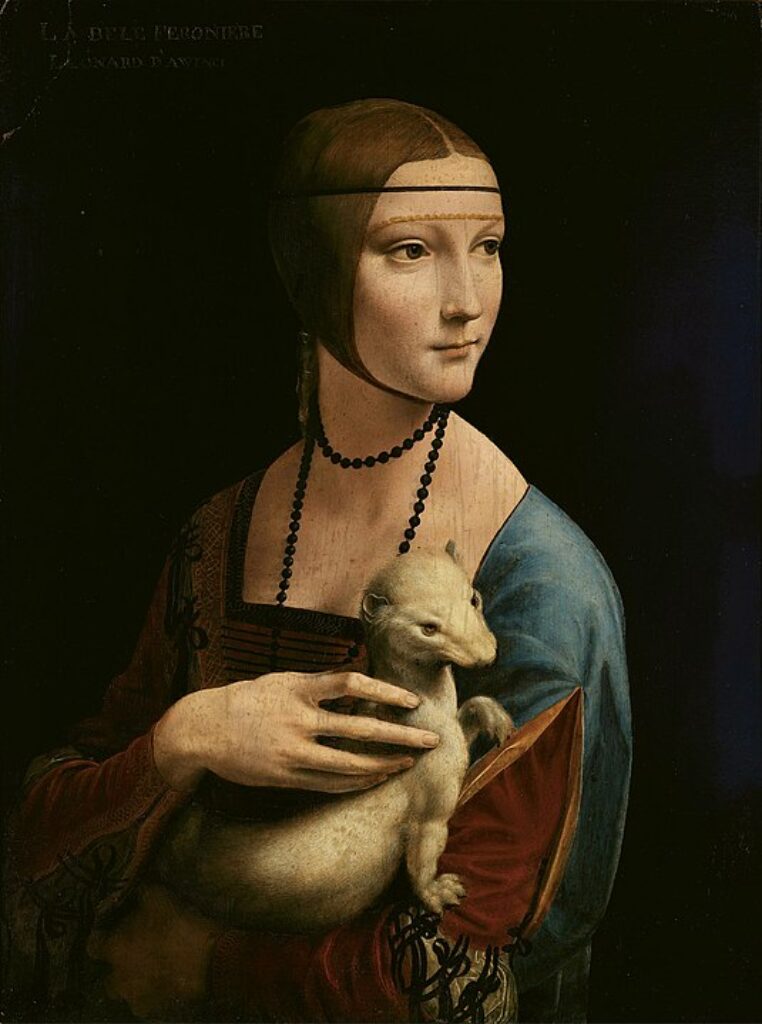 Lady with an Ermine Renaissance Painting of Woman |
Lady with an Ermine (c. 1489–1491) by Leonardo da Vinci is one of the most famous Renaissance portraits, celebrated for its exquisite detail, psychological depth, and innovative techniques. The painting features Cecilia Gallerani, the young mistress of Ludovico Sforza, Duke of Milan, holding an ermine, a symbol of purity and also a reference to Ludovico, who was known as “The White Ermine.”
Leonardo’s mastery of sfumato (the soft blending of tones and colors) gives Cecilia’s face a lifelike quality, making her expression appear both mysterious and intelligent. Unlike traditional Renaissance portraits, where sitters are static, Cecilia is slightly turned, creating a sense of movement and realism. Her gaze and gentle hand gesture enhance the painting’s depth and narrative.
The Lady with an Ermine stands as a witness to Leonardo’s genius, showcasing his deep understanding of anatomy, light, and emotion. It remains one of the most captivating portraits in art history.
4. Primavera : Sandro Botticelli
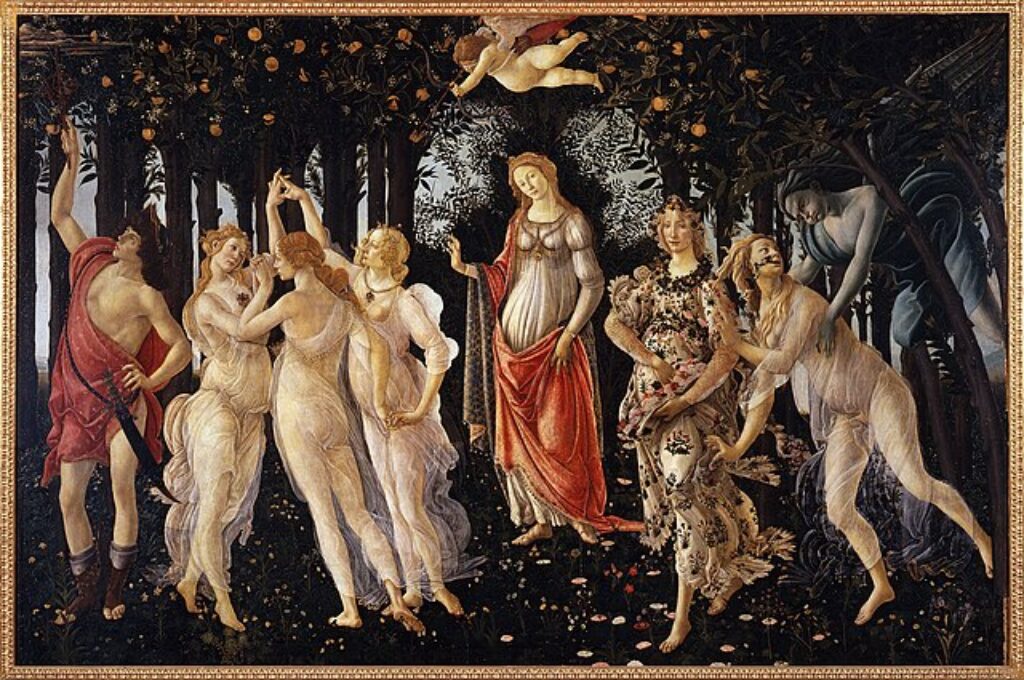 Primavera Renaissance Painting of Woman |
Sandro Botticelli’s Primavera (c. 1482) is one of the most famous and enchanting paintings of the Italian Renaissance. It stands out for its masterful composition, allegorical richness, and delicate beauty. The artwork, housed in the Uffizi Gallery in Florence, is a celebration of spring, fertility, and love, featuring mythological figures in a lush, dreamlike garden.
Botticelli’s flowing lines, graceful figures, and intricate details create a sense of movement and ethereal elegance. The central figure, Venus, embodies harmony, while the surrounding characters, including the Three Graces and Mercury, symbolize different aspects of love and nature. The presence of Zephyrus, the wind god, embracing the nymph Chloris, who transforms into Flora, reinforces the theme of renewal.
Beyond its aesthetic appeal, Primavera is also renowned for its mysterious symbolism and connection to Neoplatonic philosophy, making it an enduring masterpiece that continues to captivate art lovers and scholars alike.
5. La Belle Ferronnière : Leonardo da Vinci
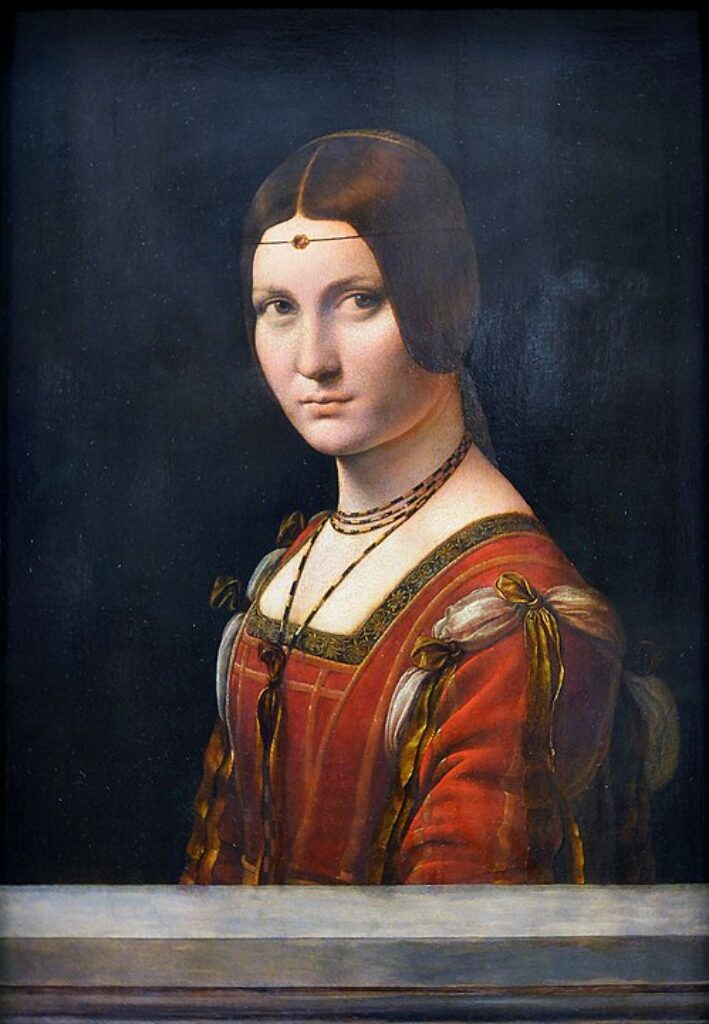 La Belle Ferronniere Renaissance Painting of Woman |
La Belle Ferronnière is a remarkable Renaissance painting attributed to Leonardo da Vinci, created between 1490 and 1496. It is special and famous due to its masterful technique, enigmatic subject, and historical significance. The painting depicts a young woman with a calm yet intense gaze, wearing a delicate ferronnière (a jeweled headband), which gives the artwork its name.
Leonardo’s use of sfumato, a technique of blending colors and tones seamlessly, adds a soft, lifelike quality to her face, demonstrating his extraordinary skill. The subject’s identity remains uncertain, adding an element of mystery that intrigues art historians and viewers alike. Some believe she was a mistress of Ludovico Sforza, Duke of Milan.
Housed in the Louvre Museum, La Belle Ferronnière continues to captivate audiences with its grace, realism, and the genius of Leonardo da Vinci, cementing its place as a masterpiece of Renaissance portraiture.
6. Venus of Urbino – Titian
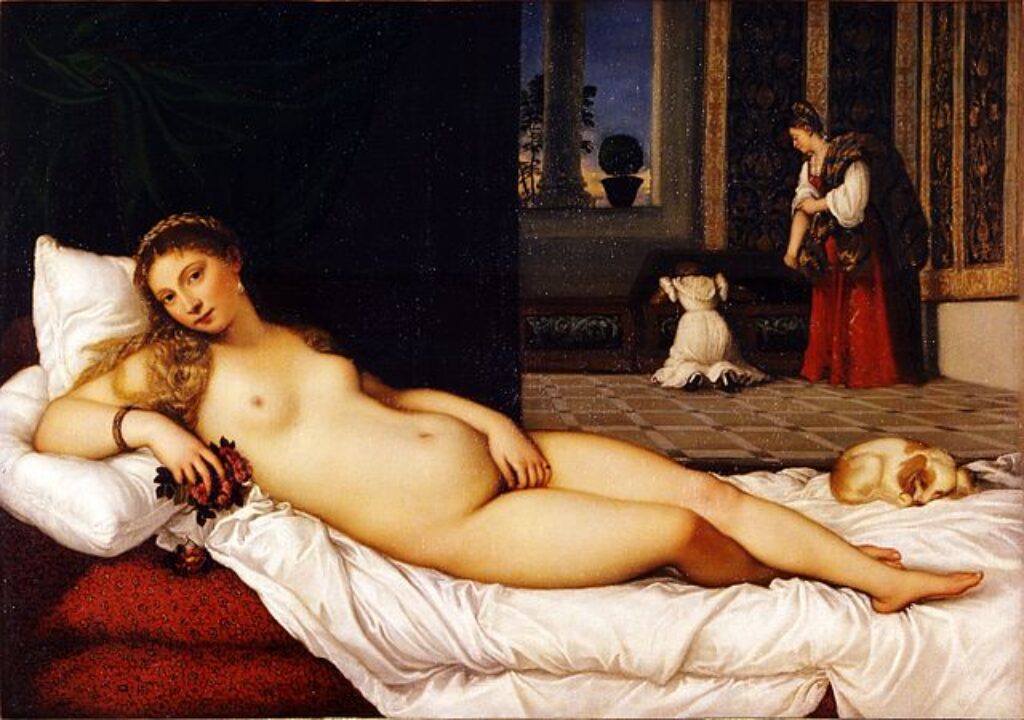 Venus of Urbino Renaissance Painting of Woman |
The Venus of Urbino (1538) by Titian is one of the most famous paintings of the Renaissance, celebrated for its sensual beauty, masterful use of color, and groundbreaking composition. Commissioned by the Duke of Urbino, Guidobaldo II Della Rovere, the painting presents a reclining nude woman, embodying both sensuality and marital fidelity. Unlike earlier depictions of Venus, Titian’s goddess gazes directly at the viewer with an intimate and confident expression, breaking conventions of passive female representation.
Titian’s use of rich, warm colors, particularly the deep reds and soft flesh tones, enhances the painting’s sensual appeal. The balance of light and shadow, along with the carefully arranged background, adds depth and realism. The painting influenced later works, including Manet’s Olympia. Its combination of eroticism and domestic symbolism, represented by the sleeping dog and maid in the background, makes it a timeless masterpiece of Renaissance art and portraiture.
6. Portrait of a Young Woman : Sandro Botticelli
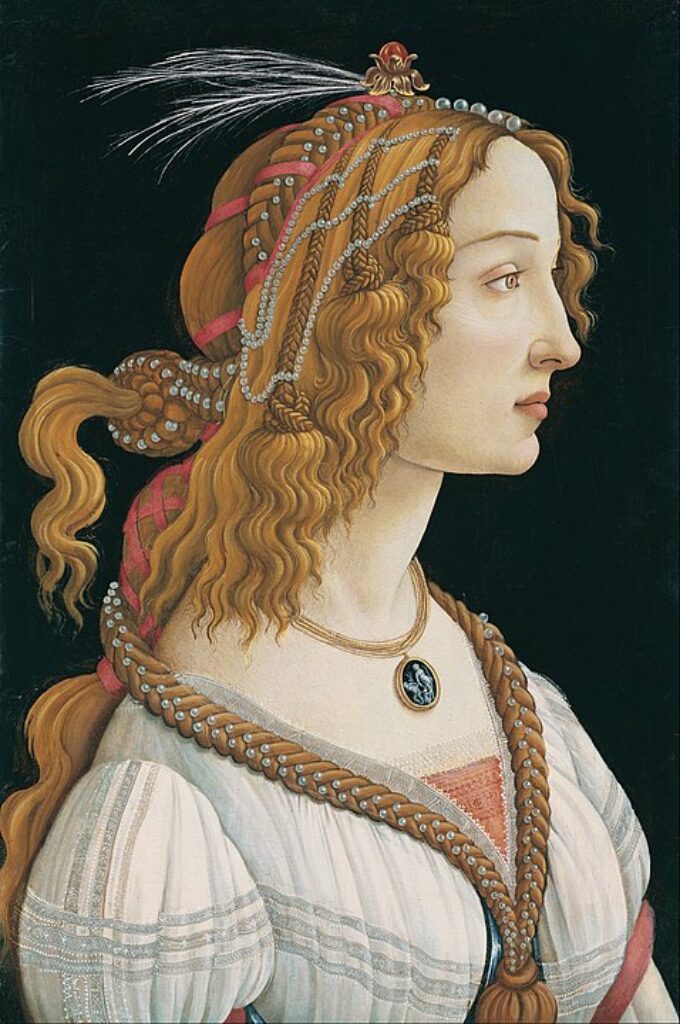 Portrait of a Young Woman Sandro Botticelli Renaissance Painting of Woman |
Portrait of a Young Woman by Sandro Botticelli is a remarkable Renaissance painting celebrated for its elegance, mystery, and technical mastery. Created in the late 15th century, it exemplifies Botticelli’s signature style, graceful lines, delicate features, and an ethereal beauty. The woman, possibly Simonetta Vespucci, a famed Florentine noblewoman, is depicted with an almost dreamlike quality, embodying the Renaissance ideal of beauty.
What makes this portrait extraordinary is its blend of realism and idealization. The intricate details of her braided hair, fine clothing, and serene expression highlight Botticelli’s skill in rendering texture and light. Unlike traditional profile portraits of the time, this piece has a subtle three-quarter view, adding depth and intimacy.
Additionally, the painting’s enduring appeal lies in its enigmatic nature. The woman’s identity remains debated, enhancing its allure. As a masterpiece of the Florentine Renaissance, it continues to captivate art lovers with its timeless elegance and refinement.
7. Portrait of Eleonora di Toledo with her Son : Bronzino
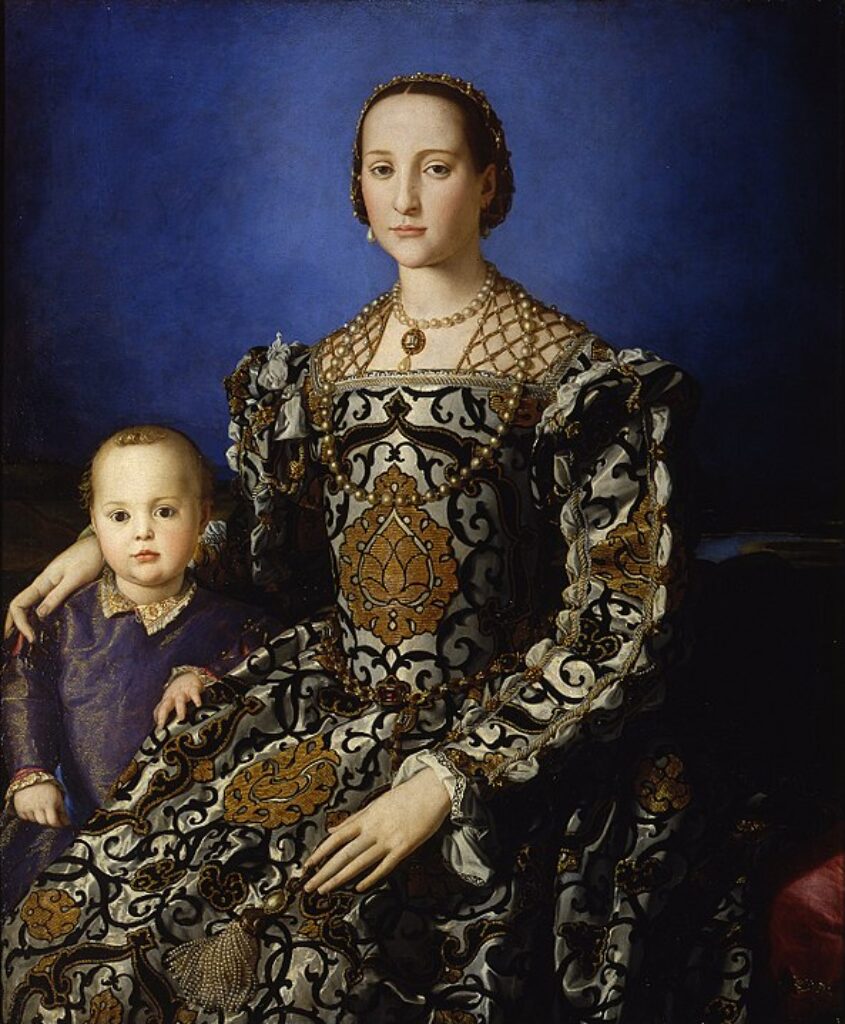 Portrait of Eleonora di Toledo with her Son Renaissance Painting of Woman |
The Portrait of Eleonora di Toledo with her Son (circa 1545) by Agnolo Bronzino is one of the most iconic Renaissance portraits. This painting is significant because it represents not only the artistic sophistication of the Mannerist style but also the power and prestige of the Medici family. Eleonora di Toledo, the wife of Cosimo I de’ Medici, is depicted in a lavish, intricately embroidered gown, showcasing her wealth and status. Her calm, detached expression and idealized beauty reflect the Mannerist emphasis on elegance and refinement.
Additionally, the inclusion of her son reinforces the Medici dynasty’s continuity and political strength. The painting’s meticulous detail, especially in the fabrics and textures, highlights Bronzino’s technical mastery. The use of cool tones and smooth, almost marble-like skin gives the portrait an ethereal quality. This work is celebrated for its symbolism, exquisite craftsmanship, and as a timeless representation of power, motherhood, and aristocratic grace.
8. Portrait of Ginevra Benci : Leonardo da Vinci
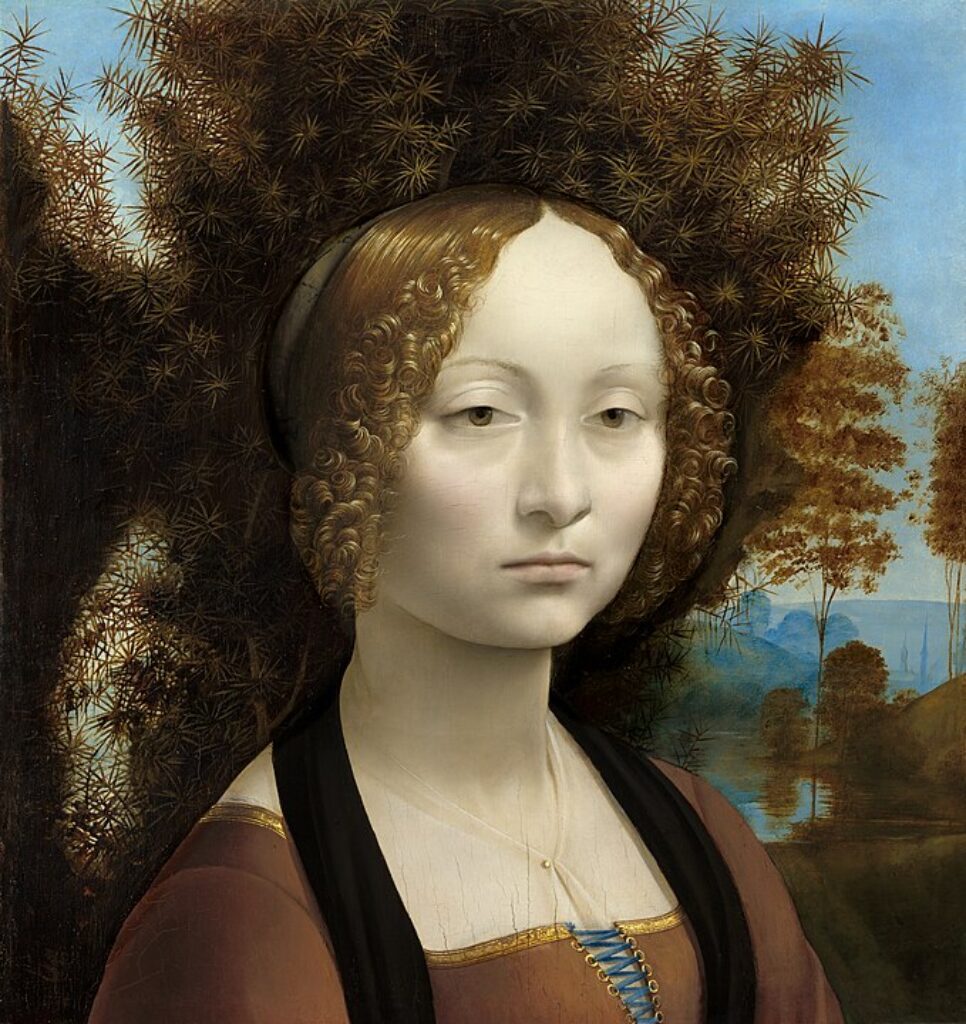 Portrait of Ginevra Benci Renaissance Painting of Woman |
Leonardo da Vinci’s Portrait of Ginevra de’ Benci is one of the most celebrated Renaissance paintings, renowned for its innovation and beauty. Painted around 1474–1478, it is Leonardo’s only portrait in the Americas and marks one of his earliest masterpieces. The painting showcases his pioneering use of sfumato, a technique that creates soft transitions between light and shadow, giving the portrait a lifelike quality.
Ginevra’s enigmatic expression and the naturalistic depiction of her features foreshadow the artist’s later masterpiece, Mona Lisa. The juniper bush behind her symbolizes chastity, a reference to her name, as “ginepro” means juniper in Italian. The reverse side of the panel features a Latin motto, Virtutem Forma Decorat (“Beauty Adorns Virtue”), reinforcing Renaissance ideals of intellect and grace.
This portrait stands out because of its psychological depth, technical mastery, and Leonardo’s ability to capture both realism and emotion, making it a timeless and extraordinary work.
9. Portrait of a Lady : Van der Weyden
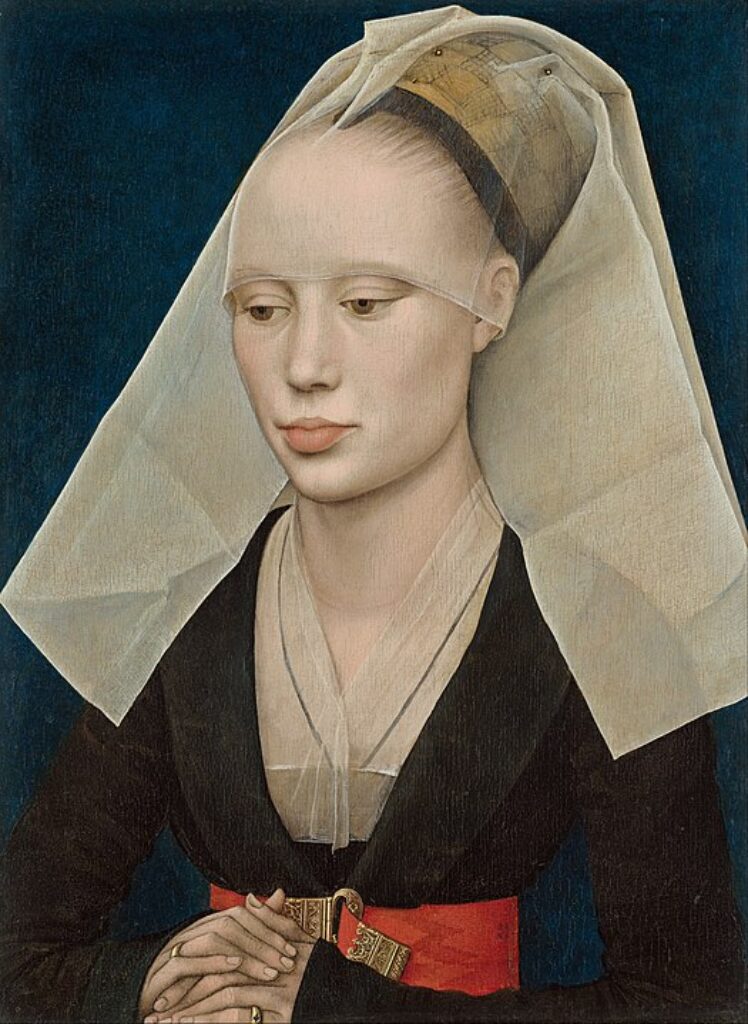 Portrait of a Lady van der Weyden Renaissance Painting of Woman |
Rogier van der Weyden’s Portrait of a Lady (c. 1460) is one of the most exquisite examples of Northern Renaissance portraiture. This masterpiece is celebrated for its striking realism, delicate detail, and emotional depth. Van der Weyden was a master of oil painting, and his technique allowed for incredibly smooth transitions of light and shadow, giving the subject an almost lifelike presence.
The lady’s serene expression, downcast eyes, and modest pose reflect the era’s ideals of femininity and virtue. The geometric elegance of her veil and the triangular composition enhance the painting’s refined aesthetic. Unlike many portraits of the time, which aimed for grandeur, van der Weyden focused on psychological depth, making the subject feel intimate and real.
This work remains famous for its perfect balance of technical skill and subtle emotion, showcasing van der Weyden’s ability to blend realism with an idealized sense of beauty, influencing portraiture for centuries.
10. La velata : Raphael
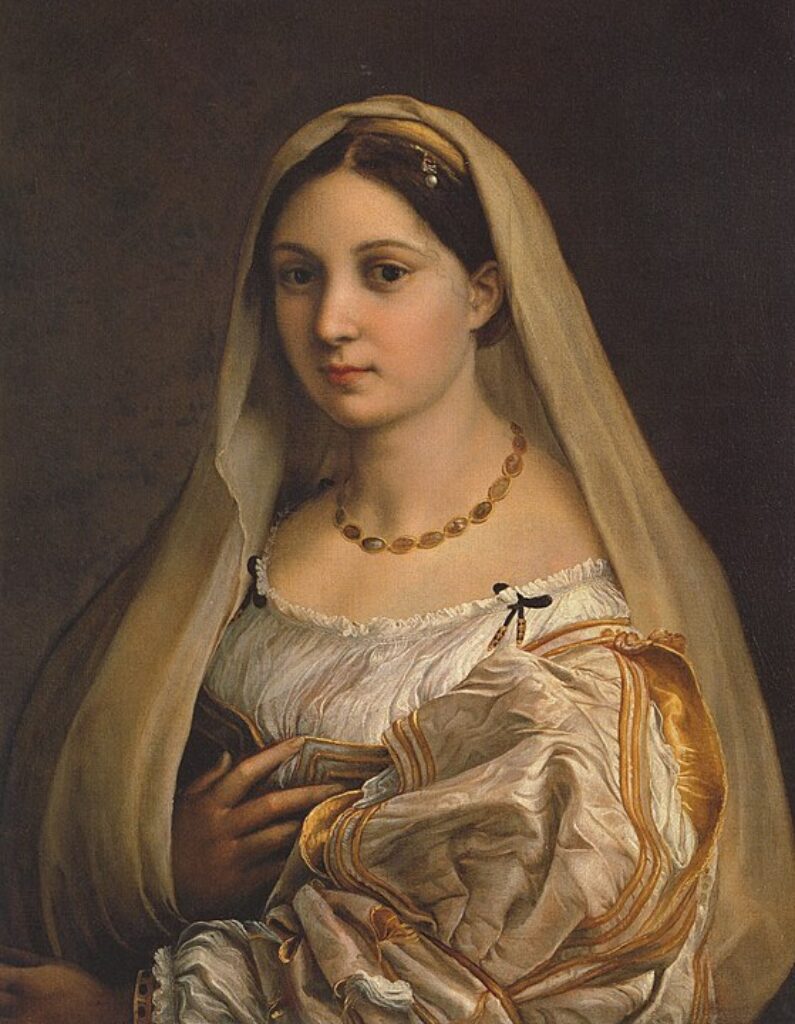 La velata Raphael Renaissance Painting of Woman |
Raphael’s La Velata (c. 1516) is one of the most celebrated portraits of the Italian Renaissance, admired for its exquisite beauty, technical mastery, and emotional depth. The painting depicts a woman, often identified as Raphael’s muse and lover, Margherita Luti, with a serene yet enigmatic expression. Her delicate features, soft gaze, and the luminous quality of her skin showcase Raphael’s unparalleled skill in rendering human form with lifelike realism.
The painting is renowned for its stunning use of chiaroscuro (light and shadow) and sfumato (soft transitions), techniques perfected during the High Renaissance. The rich textures of the woman’s luxurious clothing, especially the finely detailed veil from which the painting gets its name, demonstrate Raphael’s meticulous attention to detail. La Velata captures the ideal of Renaissance beauty and grace, making it a masterpiece of portraiture that continues to captivate audiences and art historians alike.
11. Portrait of Madame X : John Singer Sargent
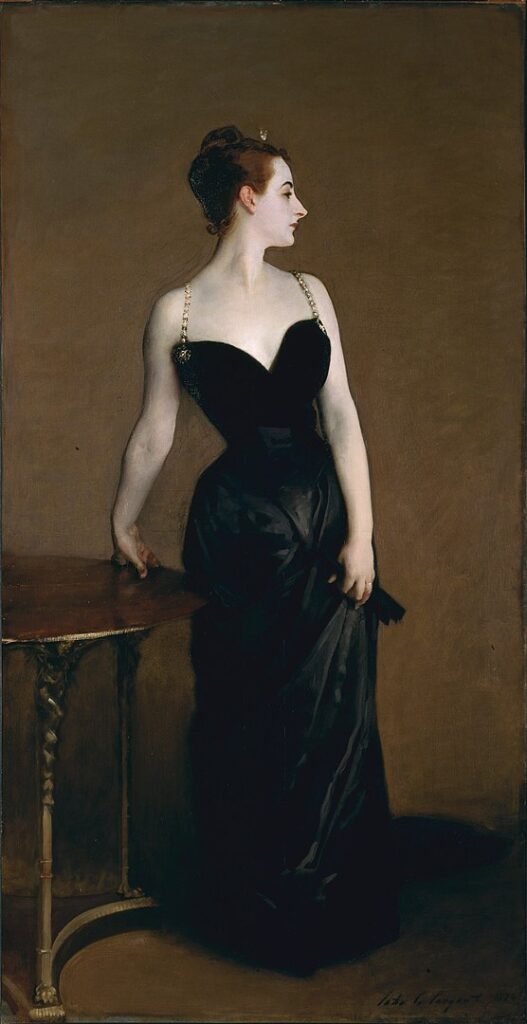 Portrait of Madame X American Renaissance Painting of Woman |
Portrait of Madame X by John Singer Sargent is one of the most famous and controversial portraits of the 19th century. Painted in 1883–1884, it captures Virginie Amélie Avegno Gautreau, a Parisian socialite known for her striking beauty. The painting was initially scandalous due to its daring composition, Madame X’s pale skin contrasts dramatically with her dark dress, and in the original version, one strap of her gown had fallen off her shoulder, suggesting sensuality and confidence. This bold portrayal shocked French society, damaging Sargent’s reputation in Paris.
What makes the painting so special is Sargent’s masterful technique, reminiscent of Renaissance portraiture, with exquisite attention to detail, lighting, and form. The influence of artists like Titian and Velázquez is evident in his use of chiaroscuro and rich textures. Over time, Portrait of Madame X became an icon of elegance and modern beauty, cementing Sargent’s legacy as a master portraitist.
12. Young Woman with Unicorn : Raphael
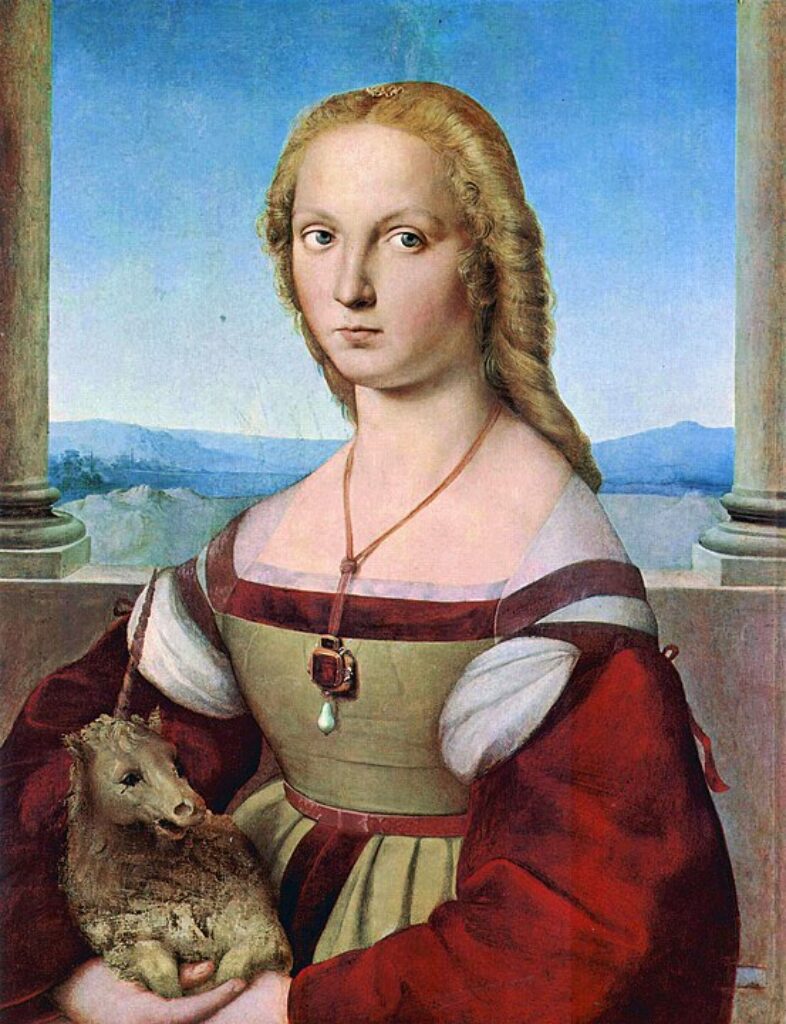 Young Woman with Unicorn Renaissance Painting of Woman |
Raphael’s Young Woman with Unicorn (c. 1505-1506) is a masterpiece of the Italian Renaissance, celebrated for its elegance, symbolism, and technical brilliance. The painting showcases Raphael’s signature style, soft, idealized beauty, harmonious composition, and exquisite use of color and light. The young woman, resembling the Mona Lisa, gazes directly at the viewer with serene confidence, while the unicorn, a symbol of purity and chastity, rests in her lap, reinforcing themes of virtue.
What makes this painting particularly special is its history of transformation. X-ray analysis revealed that the unicorn was originally a dog, possibly altering the painting’s original meaning. This change reflects how Renaissance artists adapted their works to suit different patrons or evolving iconography. Additionally, Raphael’s skill in capturing delicate textures, such as the woman’s luxurious garments and the soft curls of her hair, elevates this portrait to one of the finest examples of High Renaissance artistry.
13. Woman with a Mirror : Titian
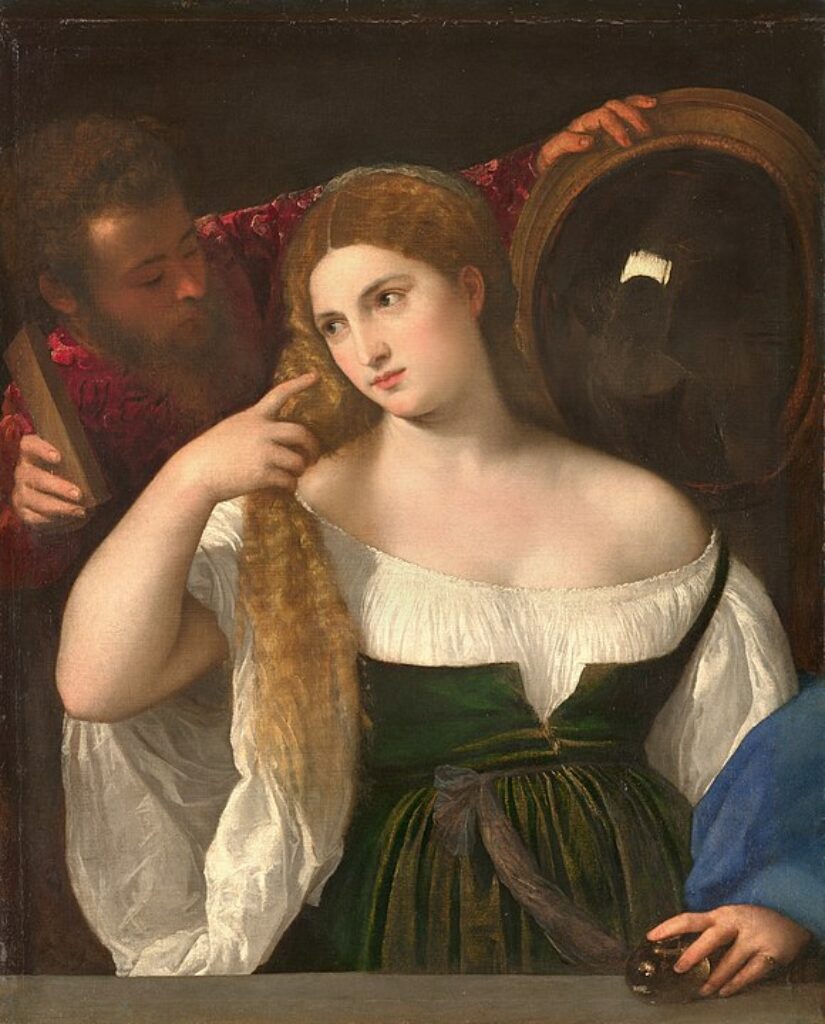 Woman with a Mirror Renaissance Painting of Woman |
Woman with a Mirror by Titian is one of the most captivating Renaissance paintings, celebrated for its masterful use of color, light, and sensual elegance. Painted around 1515, the artwork exemplifies Titian’s ability to blend naturalism with idealized beauty. The painting depicts a young woman gazing into a mirror held by a man, possibly a representation of vanity or self-reflection.
Titian’s brushwork and rich, glowing tones bring the scene to life, showcasing his skill in rendering soft flesh, luxurious fabrics, and luminous skin. The dual reflection in the mirror adds a layer of complexity, playing with perspective and perception. The painting also embodies the Venetian Renaissance style, emphasizing warmth and intimacy.
Famous for its mysterious subject and sensual charm, Woman with a Mirror remains a masterpiece of the High Renaissance, admired for its psychological depth and innovative composition, making it one of Titian’s most celebrated works.
14.Marriage Portrait of a Bolognese Noblewoman : Lavinia Fontana
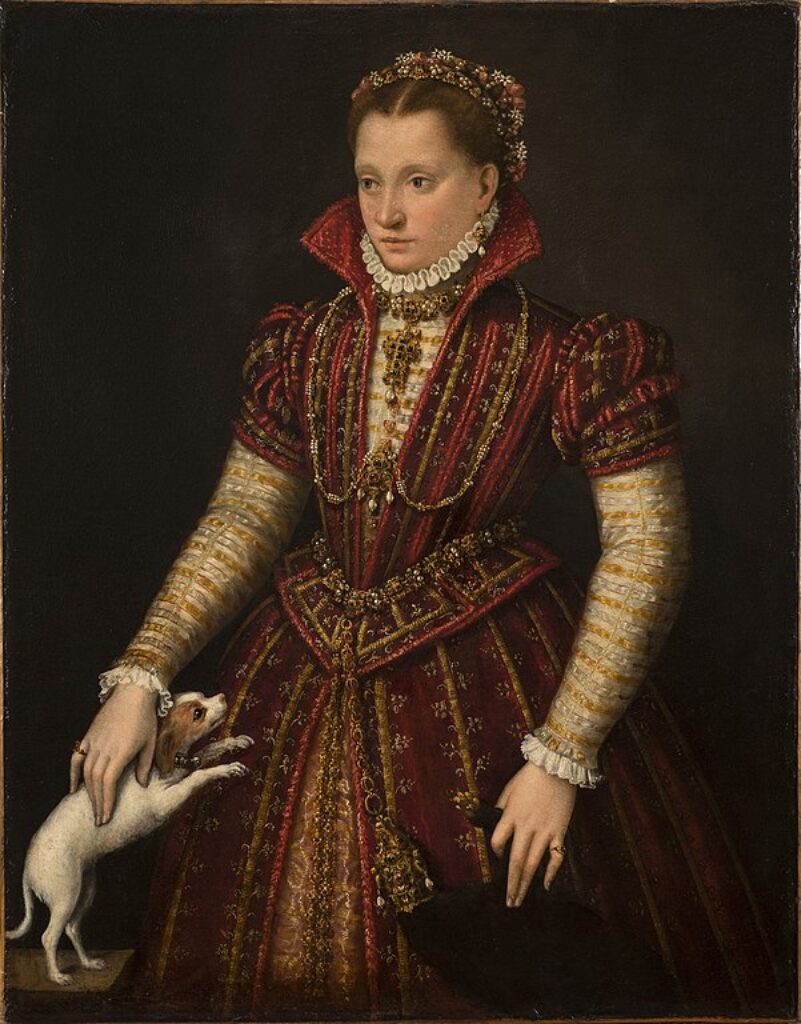 Marriage Portrait of a Bolognese Noblewoman Renaissance Painting of Woman |
Marriage Portrait of a Bolognese Noblewoman by Lavinia Fontana is a remarkable Renaissance painting, celebrated for both its artistic mastery and historical significance. Fontana, one of the first professional female artists in Europe, broke barriers in a male-dominated field, making this portrait an exceptional example of her skill and influence.
The painting is notable for its intricate detail, particularly in the luxurious clothing and elaborate jewelry of the noblewoman, which reflect the wealth and status of her family. Fontana’s ability to capture textures, such as silk, lace, and pearls, demonstrates her technical brilliance. Additionally, the noblewoman’s direct gaze and dignified expression challenge traditional depictions of women in Renaissance portraiture, emphasizing intelligence and individuality.
This work also highlights the cultural and societal expectations of women in 16th-century Italy, making it an invaluable historical artifact. Fontana’s legacy as a pioneering female artist continues to inspire admiration and scholarly interest today.
Baroque Period
1. Girl with a Pearl Earring : Johannes Vermeer
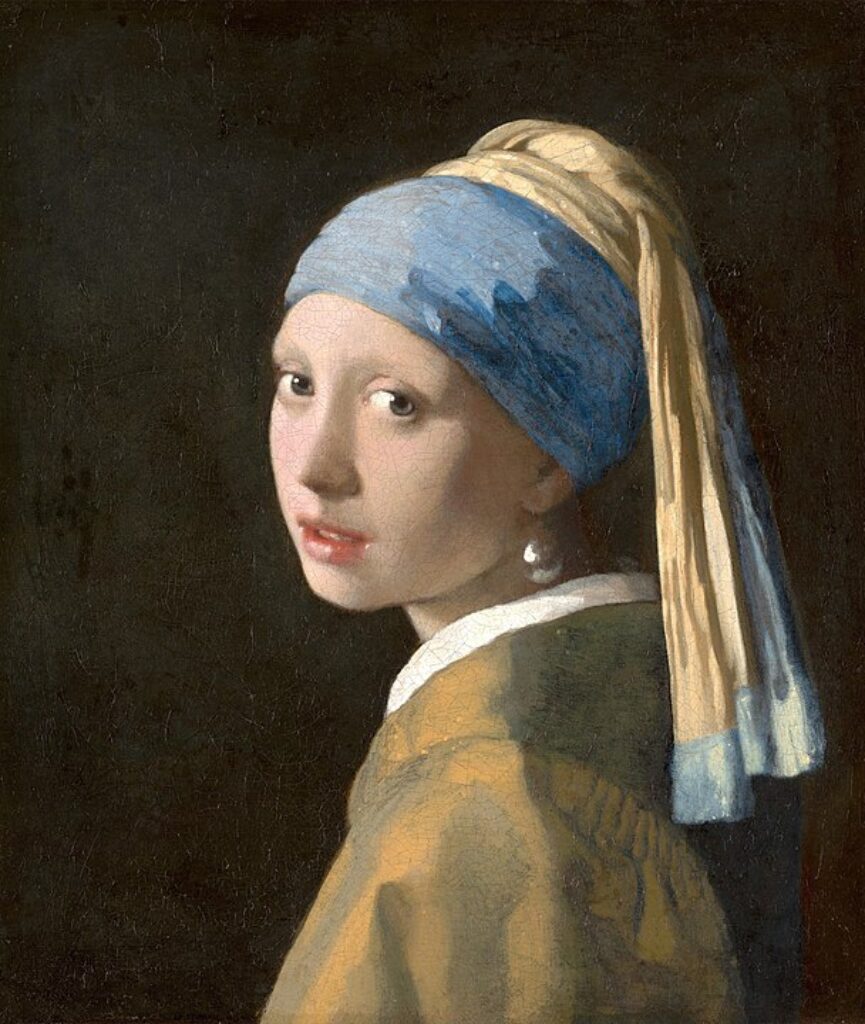 Girl with a Pearl Earring Baroque Painting of Woman |
Girl with a Pearl Earring by Johannes Vermeer is one of the most famous paintings in the world due to its mesmerizing realism, mysterious subject, and masterful use of light. Painted in the Dutch Golden Age (c. 1665), it captures a young girl in a blue and gold turban, her lips slightly parted, and her gaze engaging the viewer with an almost lifelike presence. The pearl earring, reflecting light with delicate precision, adds to the painting’s allure.
Unlike traditional portraits, this painting is a tronie, a study of facial expression rather than an identity-specific portrait. The girl’s enigmatic expression and the soft, naturalistic lighting make her appear almost alive, an effect Vermeer achieved through his expert use of light and shadow.
The painting’s enduring fame also comes from its sense of mystery, who was the girl? This intrigue, combined with Vermeer’s unmatched technical skill, makes it a timeless masterpiece of the Baroque era.
The Female Body
One of the most striking aspects of Renaissance painting of woman is the way that it celebrated the female body. Artists of the time were fascinated by the beauty of the female form, and they went to great lengths to capture its curves and contours in their paintings. Women were often depicted in a way that emphasized their sensuality and femininity, with flowing hair, soft skin, and ample curves. These depictions were not always realistic, of course, but they were intended to capture the essence of the feminine ideal.
One of the most famous examples of this is the painting “The Birth of Venus” by Sandro Botticelli. This painting depicts the goddess Venus emerging from the sea, fully formed and completely naked. Her body is perfectly proportioned and exquisitely beautiful, with long flowing hair and soft curves that seem to invite the viewer’s gaze. The painting is a celebration of feminine beauty and sensuality, and it has inspired countless imitations and interpretations over the centuries.
The Female Dress
Another important aspect of Renaissance painting of woman is the way that it depicted their dress. Women of the time were often depicted wearing elaborate and ornate clothing, with layers of fabric, intricate embroidery, and opulent jewelry. These clothing choices were not just about style, but also about status and power. Women who could afford to dress in such a way were often members of the upper classes, and their clothing was a symbol of their wealth and social standing.
One famous example of this is the painting “Portrait of a Lady” by Hans Holbein the Younger. This painting depicts a wealthy woman wearing a sumptuous black dress, with a fur collar and gold chain. Her hair is pulled back in a simple style, and she looks directly at the viewer with an expression that is both confident and alluring. The painting is a testament to the power of dress in conveying status and authority.
The Female Pet
Another intriguing aspect of Renaissance painting of woman is the way that it often depicted them with pets. Women of the time were often depicted with small dogs or cats, which were seen as symbols of their femininity and domesticity. These pets were often portrayed as playful and affectionate, and they added an extra layer of charm and whimsy to the paintings.
One famous example of this is the painting “Portrait of a Young Woman with a Dog” by Lorenzo Lotto. This painting depicts a young woman holding a small dog in her lap, with a serene expression on her face. The dog is a symbol of her gentle and nurturing nature, and it adds an extra layer of warmth and intimacy to the painting.
The Female Hair
Hair was another important element in Renaissance painting of woman. Women of the time often wore their hair long and flowing, and it was seen as a symbol of their beauty and femininity. Hair was also a symbol of youth and vitality, and it was often depicted as shiny and lustrous in the paintings.
One famous example of this is the painting “Mona Lisa” by Leonardo da Vinci. This painting depicts a woman with long, dark hair that cascades down her back in gentle waves. Her hair is a symbol of her sensuality and femininity.


